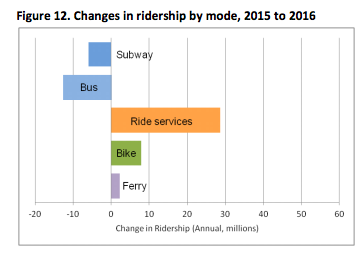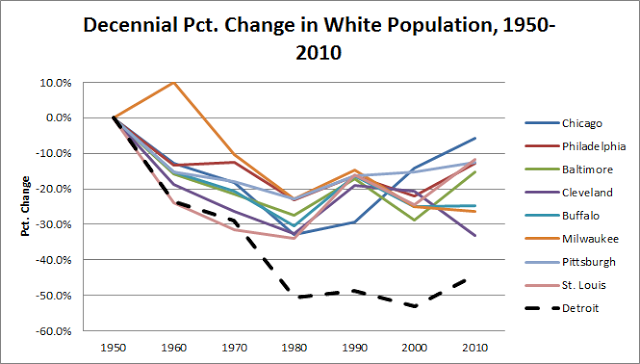What City Observatory did this week
1. More flawed congestion rankings. Traffic analysis firm Inrix released yet another report purporting to estimate the dollar cost of congestion and ranking the world’s cities from most to least traffic burdened. Our review shows that the report suffers from many of the same problems that plagued its predecessors. Chief among them: congestion indices ignore differences in commute distances among cities, understating the travel time advantages enjoyed by residents of more compact metro areas. The new Inrix report differs just enough from previous versions that its not possible to do time series analysis, which undercuts the practical value of the data. Finally, despite claims that congestion costs commuters billions, the report never identifies any feasible set of investments that would provide enough capacity to alleviate congestion at a cost lower than the supposed cost of congestion, and without triggering additional induced traffic.
2. Uber & Lyft swamping New York streets. For a while, the growth of transportation network companies, aka “ride-sharing,” mostly took market share away from yellow cabs. But as they’ve continued to grow, they’re actually increasing the total volume of vehicles on New York City streets, pushing the city toward gridlock, according to a new report from Bruce Schaller, a former city transportation official. Ride-sharing companies have added 600 million vehicle miles of travel to city streets, and their growth has pushed reversed a 24 year trend in which most additional trips were taken by transit.

3. The real welfare cadillacs have 18 wheels. Truck freight movement gets a subsidy of between $57 and $128 billion annually in the form of uncompensated social costs, over and above what trucks pay in taxes, according to the Congressional Budget Office. If trucking companies paid the full costs associated with moving truck freight, we’d have less road damage and congestion, fewer crashes, and more funding to pay for the transportation system.
4. What the meltdown by Uber’s CEO tells us about the company’s prospects. Between sexual harassment charges, a powerful #DeleteUber campaign, and defending claims that it has stolen another company’s self-driving car technology, it’s been a tough month for Uber. Tellingly, the video of a blow-up between CEO Travis Kalanick and one of the company’s drivers reveals that competition is having a material effect on the company’s strategy and profits. Kalanick’s admission that they’ve had to cut rates to meet competition seems to confirm many of the doubts that analysts have expressed about the long-term financial viability of the firm’s business model. By some estimates, Uber’s investors are underwriting 59 cents of every dollar it costs to provide a ride.
Must read
1. Another take on Detroit. Pete Saunders, who blogs at the Corner Side Yard, weighs in with his views on last week’s brouhaha over whether to view Detroit’s economic recovery as a glass half-full or half-empty. Pete’s clearly in the “half-full” camp: “Detroit’s recovery? O Yeah, its Real Alright.” By his reckoning, in its decline, Detroit’s fallen further than just about any other city in the US. And that’s what makes its rebound all the more remarkable. As one measure of the city’s challenges, Saunders charts the change in the city’s white population compared to other older industrial cities. While other cities such as Cleveland, St. Louis and Buffalo all experienced white flight, none experienced anything like Detroit, where each decade after 1970, the white population fell by half, for a cumulative 96 percent decline in the white population from 1950 through 2010. Given this backdrop, the modest gains recorded in recent years are a clear reversal of a well-established downward trend.

2. Why aren’t we building more middle income housing? At Rooflines Rick Jacobus tries to answer this perennial question about housing markets. The framing goes like this: while the private market mostly builds housing for upper income households, and we have public and subsidized housing for low income households, who’s building housing for those in the middle? Part of the answer, Jacobus points out, is that the opportunities to build new units are numerically constrained by local zoning laws. If the market is constrained to a certain number of houses, builders find it most profitable to build for the high end of the market, unlike say in the market for automobiles, where car makers, who don’t face a numeric limit on their output build different models for different segments of the market. Its a bit more complicated than that, as Jacobus acknowledges, because houses are much more long-lived than cars, and also because their are important spillover effects (your neighbor’s house has a much bigger impact on your house than your neighbor’s car). While this is an important question to contemplate, Jacobus doesn’t really offer up any answers, and one suggestion–that planner’s spend more time talking explicitly about the class identity neighborhoods–seems fraught with controversy.
New research
1. Immigrants and crime. Despite the President’s claims to the contrary, immigrants to the United States are less likely than native born Americans to commit crimes. Writing in the Journal of Ethnicity in Criminal Justice, Robert Adelman and co-authors look at 40 years of data on crime rates and immigrant status by metropolitan area. They find that immigration is linked to lower levels of violent crimes and property crimes. “The results show that immigration does not increase assaults and, in fact, robberies, burglaries, larceny, and murder are lower in places where immigration levels are higher.
2. Who are your peer cities? The Federal Reserve Bank of Chicago has developed an interesting new tool that let’s you see which cities score similarly to yours on a series of indicators, including equity, resilience, economic outlook and housing. In each of these four areas, the tool identifies cities that are roughly similar as measured by selected data in that category. Housing comparisons, for example, are based on the share of pre-1980 housing, the vacancy rate, the home price to income ratio, the homeownership rate and the share of rent-burdened households. Comparisons are just for cities (i.e. using municipal boundaries), not metropolitan areas, and is therefore subject to our usual warning about the highly variable nature of city geographies. The housing peers of Los Angeles include a number of other California cities, and somewhat surprisingly, Lawrence Massachusetts.
City Observatory in the news
An an Associated Press feature published in the Detroit News and other metropolitan dailies, City Observatory’s research on the “Young and Restless” was featured. “The Plight of company towns” looked at the growing trend of company’s to move headquarters operations from smaller cities and suburban locations to urban centers in order to be able to easily hire talented young workers.

